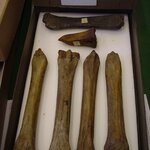Archaeology

Museum archaeologists, conservation scientists, archivists and university researchers gathered at a one-day workshop at the Science and Technology Facilities Council (STFC) Daresbury Laboratory to discuss preservation of art and artefacts as well as immovable objects such as buildings and ships.
From how STFC is currently using its world leading light source facilities to help preserve the historic timbers of the Mary Rose, to why a bronze-age wooden shovel has survived so perfectly for over 4000 years in unfavourable soil conditions - delegates took part in discussions with STFC scientists…

A Purdue University archaeologist discovered an intact ancient iron ore mine in South America that shows how civilizations before the Inca Empire were mining this valuable ore.
"Archaeologists know people in the Old and New worlds have mined minerals for thousands and thousands of years," said Kevin J. Vaughn, an assistant professor of anthropology who studies the Nasca civilization, which existed from A.D. 1 to A.D. 750. "Iron mining in the Old World, specifically in Africa, goes back 40,000 years. And we know the ancient people in Mexico, Central America and North America were mining for…

Researchers of the Group of Recent Prehistory Studies (GEPRAN) of the University of Granada, from the department of Prehistory and Archaeology, have taken an important step to determine how life was in the Iberian Peninsula in the Bronze Age.
Since 1974, archaeologists from Granada, directed by professors Trinidad Nájera Colino and Fernando Molina González, have been working on the site of the Motilla del Azuer, in the municipal area of Daimiel (province of Ciudad Real), in search of the necessary information to reconstruct the day by day in this thrilling and unknown historical period.
The…

The Syrian Archeological Team discovered parts of an architecture that included several tombs and funeral findings at Tal Shair site in the northeastern area of Hasaka dating back to the Middle Bronze Age in the 3rd millennium B.C.
Member of the Executive Bureau and in Charge of Tourism, Archeology and Arts Department Mohammad Shamsuddin in Hasaka Governorate said the team also discovered parts of another architecture made of stones and traditional ancient building blocks dating back to the Islamic period and part of a building dating back to the second half of the 3rd millennium B.C.
He…

Excavation works carried out by national and foreign archeological teams in the central Syrian Governorate of Hama has yielded several important findings in Tal al-Homsi, Apamea, al-Rawda, Ba'arin Cemetery, Tal al-Qarqour.
The teams also executed many restoration works in the ancient Shaizar Castle.
Head of Hama Department of Ruins Jamal Ramadan said significant parts of Apamea ancient city were unearthed, particularly in the northeastern corners, as well as discovering some findings including a stone statue with intact face.
Mr. Ramadan added that the Syrian-German crew discovered a stone…

Archaeological evidence shows that bone skates (skates made of animal bones) are the oldest human powered means of transport, dating back to 3000 BC. Why people started skating on ice and where is not as clear, since ancient remains were found in several locations spread across Central and North Europe.
In a recent paper, published in the Biological Journal of the Linnean Society of London, Dr. Federico Formenti and Professor Alberto Minetti show substantial evidence supporting the hypothesis that the birth of ice skating took place in Southern Finland, where the number of lakes within 100…

A team led by a Cardiff University archaeologist has reconstructed a 3,000-year-old glass furnace, showing that Ancient Egyptian glassmaking methods were much more advanced than previously thought.
Dr Paul Nicholson, of the University’s School of History and Archaeology, is leader of an Egypt Exploration Society team working on the earliest fully excavated glassmaking site in the world. The site, at Amarna, on the banks of the Nile, dates back to the reign of Akhanaten (1352 - 1336 B.C.), just a few years before the rule of Tutankhamun.
It was previously thought that the Ancient Egyptians may…

Remains of an ancient synagogue from the Roman-Byzantine era have been revealed in excavations carried out in the Arbel National Park in the Galilee under the auspices of the Hebrew University of Jerusalem.
The excavations, in the Khirbet Wadi Hamam, were led by Dr. Uzi Leibner of the Hebrew University’s Institute of Archaeology and Scholion – Interdisciplinary Research Center in Jewish Studies.
Dr. Leibner said that the synagogue’s design is a good example of the eastern Roman architectural tradition. A unique feature of the synagogue is the design of its mosaic floor, he said.
Mosaic…

Whales were the economic drivers of the 1850s. So important was this resource that the founder of the U.S. Oceanographic Office, Matthew Fontaine Maury, created a map showing the worldwide distribution of sperm and right whales in 1851.
“Whale oil then was like petroleum is today,” says Christopher Baruth. “This is a graphic device that showed where the whales were located by type and season.”
Baruth is curator of the American Geographical Society (AGS) Library, where a copy of the whale map is one of thousands of rare cartographical materials and geographical photographs.
The Mappamundi…

Cashew nut fossils have been identified in 47-million year old lake sediment in Germany, revealing that the cashew genus Anacardium was once distributed in Europe, remote from its modern “native” distribution in Central and South America.
It was previously proposed that Anacardium and its African sister genus, Fegimanra, diverged from their common ancestor when the landmasses of Africa and South America separated. However, groundbreaking new data in the October issue of the International Journal of Plant Sciences indicate that Europe may be an important biogeographic link between Africa and…